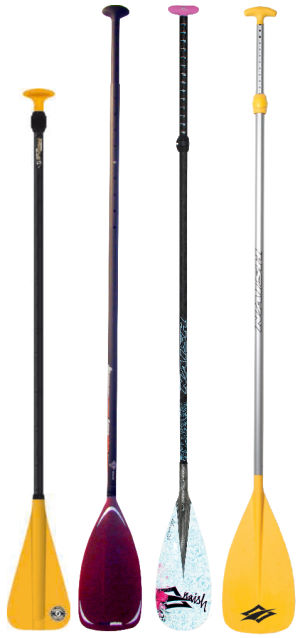Stand Up Paddleboarding: Choosing a Paddle
Stand Up Paddle Boarding: Paddle Selection
Now that you are finally giving this Stand Up Paddleboarding, or SUP, thing a try, you are inevitably facing the tough choice of determining the right gear in an oversaturated market. If picking a board wasn't enough, there is also a smorgasbord of different accessories to sift through, all complicating the decision of what to get. By understanding the core differences between different options however, selecting the right equipment to meet your needs becomes far easier. In this section, we will demystify different paddle technology and material composition, hopefully helping to alleviate the decision-making process.
Aluminum Paddles
 Aluminum paddles tend to be the entry level paddle for Stand Up Paddleboarding. They typically have a plastic blade mounted on an aluminum shaft, causing them to be heavier. To prevent sinking, most come with a foam insert, but as that degrades over time they do have the unfortunate tendency to sink. Aluminum is also much more susceptible to temperature variances, most noticeable if used in cold water or air temperatures. The aluminum paddle is going to be quite durable however, making it appropriate for those paddleboarders who expect their boards to get a lot of use. I also prefer an aluminum paddle in the surf due to the durability, as when leveraging the paddle in a wave the force can crack carbon fiber/graphite composite paddles.
Aluminum paddles tend to be the entry level paddle for Stand Up Paddleboarding. They typically have a plastic blade mounted on an aluminum shaft, causing them to be heavier. To prevent sinking, most come with a foam insert, but as that degrades over time they do have the unfortunate tendency to sink. Aluminum is also much more susceptible to temperature variances, most noticeable if used in cold water or air temperatures. The aluminum paddle is going to be quite durable however, making it appropriate for those paddleboarders who expect their boards to get a lot of use. I also prefer an aluminum paddle in the surf due to the durability, as when leveraging the paddle in a wave the force can crack carbon fiber/graphite composite paddles.
Carbon Paddles
Paddles composed of a graphite fiber or a carbon composite are going to be quite a bit lighter than their aluminum counterparts, lending themselves to longer paddleboard trips with less arm muscle fatigue. On a molecular level, carbon (or graphite) fiber chains provide a high strength to volume ratio, leading to an increased stiffness and consequently low weight. It also has a high temperature tolerance, resulting in less temperature extremes, and a high resistance to chemical weathering for a longer lifetime. Carbon paddles are ideal for those individuals who plan on paddling frequently for extended periods, or live in climates with colder temperatures.
Fixed versus Adjustable Paddle
Another dilemma facing SUP enthusiasts is whether to choose an adjustable or non-adjustable paddle. By and large, the adjustable paddle will be the preferable course due to the high range of use. For new paddlers, an adjustable paddle allows them to experiment with different lengths to find their ideal stroke (generally six to eight inches above the head). For those who are planning on riding both in flat water and surf, adjustable paddles also allow the rider to shorten the length of the paddle to surf with greater control and leverage, and then restore its size for calmer conditions. If you are sharing a board with different family members and friends, an adjustable paddle allows the majority of people to easily resize the paddle to match their height and have a comfortable experience. With that said, the extra length does add weight to adjustable paddles. For those paddle boarders planning to be the exclusive users of their boards, and pursuing racing or long distance and frequent SUP trips, a fixed paddle is preferable, as it is lighter, cut specifically to height, and stiffer with no flex.
Paddle Blade Size
The size of the paddle blade is going to be of little consequence to the recreational user, but differences do exist. A paddle blade with a smaller face will offer less resistance and consequently allow for high stroke cadence (more strokes per minute). This leads also to quicker acceleration, and causes less fatigue as less effort is required per stroke. A paddle blade with a larger face creates more resistance and power. This is intended for maintaining higher cruising speeds. For conditioned paddlers or individuals seeking a workout, a low-cadence paddle should be considered.
Jake Mitchell
Age: 23
Weight: 180 after a few cheeseburgers
Years SUPing: 3
Lessons Given: Countless
